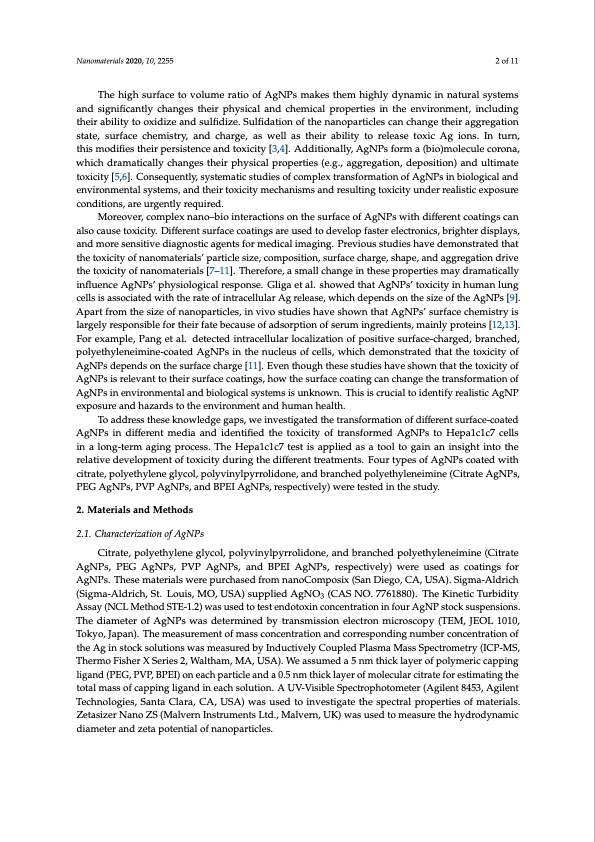
PDF Publication Title:
Text from PDF Page: 002
Nanomaterials 2020, 10, 2255 2 of 11 The high surface to volume ratio of AgNPs makes them highly dynamic in natural systems and significantly changes their physical and chemical properties in the environment, including their ability to oxidize and sulfidize. Sulfidation of the nanoparticles can change their aggregation state, surface chemistry, and charge, as well as their ability to release toxic Ag ions. In turn, this modifies their persistence and toxicity [3,4]. Additionally, AgNPs form a (bio)molecule corona, which dramatically changes their physical properties (e.g., aggregation, deposition) and ultimate toxicity [5,6]. Consequently, systematic studies of complex transformation of AgNPs in biological and environmental systems, and their toxicity mechanisms and resulting toxicity under realistic exposure conditions, are urgently required. Moreover, complex nano–bio interactions on the surface of AgNPs with different coatings can also cause toxicity. Different surface coatings are used to develop faster electronics, brighter displays, and more sensitive diagnostic agents for medical imaging. Previous studies have demonstrated that the toxicity of nanomaterials’ particle size, composition, surface charge, shape, and aggregation drive the toxicity of nanomaterials [7–11]. Therefore, a small change in these properties may dramatically influence AgNPs’ physiological response. Gliga et al. showed that AgNPs’ toxicity in human lung cells is associated with the rate of intracellular Ag release, which depends on the size of the AgNPs [9]. Apart from the size of nanoparticles, in vivo studies have shown that AgNPs’ surface chemistry is largely responsible for their fate because of adsorption of serum ingredients, mainly proteins [12,13]. For example, Pang et al. detected intracellular localization of positive surface-charged, branched, polyethyleneimine-coated AgNPs in the nucleus of cells, which demonstrated that the toxicity of AgNPs depends on the surface charge [11]. Even though these studies have shown that the toxicity of AgNPs is relevant to their surface coatings, how the surface coating can change the transformation of AgNPs in environmental and biological systems is unknown. This is crucial to identify realistic AgNP exposure and hazards to the environment and human health. To address these knowledge gaps, we investigated the transformation of different surface-coated AgNPs in different media and identified the toxicity of transformed AgNPs to Hepa1c1c7 cells in a long-term aging process. The Hepa1c1c7 test is applied as a tool to gain an insight into the relative development of toxicity during the different treatments. Four types of AgNPs coated with citrate, polyethylene glycol, polyvinylpyrrolidone, and branched polyethyleneimine (Citrate AgNPs, PEG AgNPs, PVP AgNPs, and BPEI AgNPs, respectively) were tested in the study. 2. Materials and Methods 2.1. Characterization of AgNPs Citrate, polyethylene glycol, polyvinylpyrrolidone, and branched polyethyleneimine (Citrate AgNPs, PEG AgNPs, PVP AgNPs, and BPEI AgNPs, respectively) were used as coatings for AgNPs. These materials were purchased from nanoComposix (San Diego, CA, USA). Sigma-Aldrich (Sigma-Aldrich, St. Louis, MO, USA) supplied AgNO3 (CAS NO. 7761880). The Kinetic Turbidity Assay (NCL Method STE-1.2) was used to test endotoxin concentration in four AgNP stock suspensions. The diameter of AgNPs was determined by transmission electron microscopy (TEM, JEOL 1010, Tokyo, Japan). The measurement of mass concentration and corresponding number concentration of the Ag in stock solutions was measured by Inductively Coupled Plasma Mass Spectrometry (ICP-MS, Thermo Fisher X Series 2, Waltham, MA, USA). We assumed a 5 nm thick layer of polymeric capping ligand (PEG, PVP, BPEI) on each particle and a 0.5 nm thick layer of molecular citrate for estimating the total mass of capping ligand in each solution. A UV-Visible Spectrophotometer (Agilent 8453, Agilent Technologies, Santa Clara, CA, USA) was used to investigate the spectral properties of materials. Zetasizer Nano ZS (Malvern Instruments Ltd., Malvern, UK) was used to measure the hydrodynamic diameter and zeta potential of nanoparticles.PDF Image | Silver Nanoparticles Undergoing Long-Term Aging

PDF Search Title:
Silver Nanoparticles Undergoing Long-Term AgingOriginal File Name Searched:
nanomaterials-10-02255-v3.pdfDIY PDF Search: Google It | Yahoo | Bing
Turbine and System Plans CAD CAM: Special for this month, any plans are $10,000 for complete Cad/Cam blueprints. License is for one build. Try before you buy a production license. More Info
Waste Heat Power Technology: Organic Rankine Cycle uses waste heat to make electricity, shaft horsepower and cooling. More Info
All Turbine and System Products: Infinity Turbine ORD systems, turbine generator sets, build plans and more to use your waste heat from 30C to 100C. More Info
CO2 Phase Change Demonstrator: CO2 goes supercritical at 30 C. This is a experimental platform which you can use to demonstrate phase change with low heat. Includes integration area for small CO2 turbine, static generator, and more. This can also be used for a GTL Gas to Liquids experimental platform. More Info
Introducing the Infinity Turbine Products Infinity Turbine develops and builds systems for making power from waste heat. It also is working on innovative strategies for storing, making, and deploying energy. More Info
Need Strategy? Use our Consulting and analyst services Infinity Turbine LLC is pleased to announce its consulting and analyst services. We have worked in the renewable energy industry as a researcher, developing sales and markets, along with may inventions and innovations. More Info
Made in USA with Global Energy Millennial Web Engine These pages were made with the Global Energy Web PDF Engine using Filemaker (Claris) software.
Infinity Turbine Developing Spinning Disc Reactor SDR or Spinning Disc Reactors reduce processing time for liquid production of Silver Nanoparticles.
| CONTACT TEL: 608-238-6001 Email: greg@infinityturbine.com | RSS | AMP |